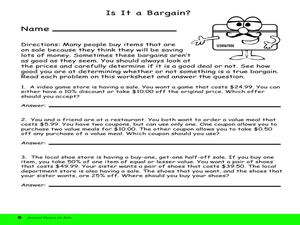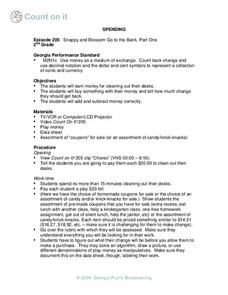Curated OER
How Do You Spend Your Money?
Fifth graders examine ways to save and spend money. They look at ways that people earn, save, and spend money using chapters from Tom Birdseye's Tarantula Shoes. They add and subtract decimals to fill in a worksheet entitled, "Is It a...
Curated OER
Money - Using R & R to Teach Mathematics
Second graders count up coins of money that add up to one dollar. In this money lesson plan, 2nd graders also spend money and keep track of how much they have spent.
Curated OER
Using Credit and Spending Money Wisely
Students discuss how to spend money wisely. In this consumer math lesson, students read the book, Mr. Popper's Penguins and discuss how much it costs to take care of a pet. Students complete a worksheet to calculate the total cost of pet...
Curated OER
Money Counts
Fourth graders identify bills and coins to $20 bills and make equivalencies. They organize bills and coins in groups from greatest to least and least to greatest. Students count out change.
Curated OER
Consumer Borrowing and Spending
Credit can be confusing for teens, some of whom are already using credit cards. Clear up misconceptions with this group research activity which has a solid outline with a lot of room to adjust to your needs and resources. Groups are...
Curated OER
Spending
Student explore the value of money. In this addition and subtraction lesson, 2nd graders earn "money" for classroom jobs and spend it in the classroom. Students practice how to add prices and calculate change. This lesson incorporates...
Curated OER
Using a Calculator
Learners use a calculator to solve math problems. In this calculator usage lesson, students get into pairs and familiarize themselves with the keys. Learners are then given problems to solve using the calculator. Students do Smart Board...
Visa
A Plan for the Future: Making a Budget
From fixed and variable expenses to gross income and net pay, break down the key terms of budgeting with your young adults and help them develop their own plans for spending and saving.
Curated OER
Estimation
Select items to purchase from a store, add up the total cost, then estimate the total cost! Kids count out the money needed to make the purchase and pay for the items. An excelent way to connect real life math and estimation!
Curated OER
Currency and Exchange Rates
Fifth graders share the book, "The Story of Money" and discuss the uses of money, bartering, trade and the history of money. Students discuss various ways of spending: cash, check, debit/credit cards and review the check writing process....
Curated OER
Who Wants to Spend $20,000?
Who wouldn't want $20,000 to spend? But, the question becomes, what do you spend it on? Learners discuss loans, interest, and making adult-like financial decisions. They role-play a scenario that depicts the choices of a girl who took...
Curated OER
Classroom Supplies
Challenge young mathematicians to buy classroom supplies by staying within the means of a $1,000 budget. The mathematical activity provides learners with the opportunity to decide what items from the supply list would benefit a class of...
Curated OER
You Are The Farmer
Young scholars investigate the farming business and occupations in agriculture. Basic multi-step math operations are performed in calculating some of the expenses involved in farming.
Federal Reserve Bank
Your Budget Plan
What do Whoosh and Jet Stream have in common? They are both characters in a fantastic game designed to help students identify various positive and negative spending behaviors. Through an engaging activity, worksheets, and...
Curated OER
Using The Calculator
First graders use a calculator to total money quantities. They use plastic coins to represent the cost of an entire purchase. Students model specific dollar amounts and how to make change.
Curated OER
Spend, Save, Invest or Donate (9-12)
Students explore the concept of personal finance. In this philanthropy instructional activity, students examine decisions they make about money as they discover the definitions of philanthropy, resources, scarcity, choice, benefits,...
Curated OER
Shopping for Candy
Students explore counting money. In this money counting and gingerbread house construction lesson, students use a calculator to determine how much and what type of candy they can buy given 25 cents. Students construct gingerbread...
Curated OER
Estimation
Third graders practice using money. For this estimation lesson, 3rd graders show their ability to figure out the cost of lunch. Students then set up a "store" and students choose the products and estmate the cost. Students visit...
Federal Reserve Bank
Savvy Savers
What are the benefits and risks of saving in an interest-bearing account? Pupils explore concepts like risk-reward relationship and the rule of 72, as well as practice calculating compound interest, developing important personal...
Curated OER
How much money can you earn?
Fifth graders survey how to manage money and the importance of it. Students summarize that each day they have the opportunity to earn or lose money. Students provides many situations to present ways of paying bills and money management.
Curated OER
Party Math
Students create a spreadsheet that they will use to plan a small party or outing. They calculate expenses and stay within a budget amount for their party.
Curated OER
Learn to Earn When You Tend to Spend
Students examine spending and earning, and calculate change up to a dollar. They view and participate in demonstrations of earning and spending math problems, complete a worksheet, and play a game in pairs that simulates banking.
Curated OER
Subtraction with Calculators
First graders demonstrate an understanding of subtracting one from a number of ten or less using manipulatives, work with calculators to solve subtraction problems, and create subtraction number sentences to solve on the calculator.
Council for Economic Education
Opportunity Cost
The price of those new shoes involves more than just money! Individuals explore the concept of opportunity cost using a video clip and gratification discussions. They prepare a budget based off of their set of values in regards to...























